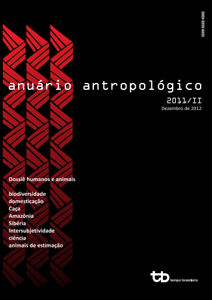Percepções da presa
caça, sedução e metamorfose entre os Yukaghirs da Sibéria
Palavras-chave:
Yukaghir, Sibéria, caça, transformação humano-animal, pessoalidadeResumo
Para os Yukaghirs da Sibéria, a presa é vista como uma amante que precisa se “entregar” ao caçador, demonstrando desejo sexual por ele. Consequentemente, o caçador busca seduzir a presa transformando seu corpo na imagem dela. Contudo, esse empreendimento é arriscado e pode resultar na perda de sua aderência à espécie original. Por essa razão, dentro do acampamento humano, o processo de caçar é oposto por um contraprocesso, implicando o esforço do caçador em sanear a alteridade do seu eu e reconstruir sua pessoalidade humana. Ainda assim, o caçador não é apenas ele mesmo, uma vez que ele acredita ser a encarnação de um parente morto. O ponto que desejo ressaltar é que a estabilidade do eu ou da pessoa é, na verdade, impossível de se manter entre os Yukaghirs, onde ninguém é apenas ele mesmo, mas sempre alguém mais.
Downloads
Referências
DESCOLA, P. 1986. La Nature Domestique: Symbolism et Praxis dans l’Ecologie des Achuar. Paris: Maison des Science de l’Homme.
_____. 1996. In the Society of Nature: A Native Ecology in Amazonia. Cambridge: Cambridge University Press.
FAUSTO, C. 2007. “Feasting on People: Eating Animals and Humans
in Amazonia”. Current Anthropology, v. 48, n. 4:497-530.
GOULET, J.G.A. 1998. Ways of Knowing: Experience, Knowledge and Power among the Dene Tha. Lincoln and London: University of Nebraska Press.
GUEMPLE, L. 1991. “Teaching Social Relations to Inuit children”. In: T. Ingold; D. Riches & J. Woodburn (eds.). Hunters and Gatherers II: Property, Power and Ideology. Oxford: Berg Publishers Ltd. pp. 131-149.
JOCHELSON, W. 1926. The Yukaghir and the Yukaghized Tungus (ed. F. Boas). New York: American Museum of Natural History.
KWON, H. 1998. “The Saddle and the Sledge: Hunting as Comparative Narrative in Siberia and Beyond”. Journal of the Royal Anthropological Institute, 4 (1):115-127.
MASLOVA, E. & VAKHTIN, N. 1996. “The Far North-east of Russia” (map and text). In: S.A. Wurm; P. Mühlhäuser & D.T. Tryon (eds.). Atlas of Languages of Intercultural Communication in the Pacific, Asia, and the Americas. Berlin and New York: Mouton de Gruyter. pp. 999-1001.
MORIN, F. & SALADIN D’ANGLURE, B. 1997. “Ethnicity as a Political Tool for Indigenous Peoples”. In: C. Govers & H. Vermeulen (eds.). The Politics of Ethnic Consciousness. London: Macmillan. pp. 157-193.
ROSALDO, R. 1986. “Ilongot Hunting as Story and Experience”. In: W. Turner & E.M. Burner (eds.). The Anthropology of Experience. Urbana, IL: University of Illinois Press. pp. 97-138.
_____. 1993. Culture and Truth: The Remaking of Social Analysis. Boston, MA: Beacon Press.
SMITH, D.M. 1998. “An Athapaskan Way of Knowing: Chipewan Ontology”. American Ethnologist, 25 (3):412”“32.
TURNER, V. 1982. From Ritual to Theatre: The Human Seriousness of Play. New York: PAJ Publications.
VAKHTIN, N. 1991. The Yukaghir Language in Sociolinguistic Perspective. Leningrad, USSR: Institute for Linguistics, Academy of Science.
VITEBSKY, P. & WOLFE, S. 2001. “The Separation of the Sexes among Siberian Reindeer Herders”. In: A. Low & S. Tremayne (eds.). Sacred Custodians of the Earth? Women, Spirituality and Environment. New York and Oxford: Berghahn Books. pp. 81-94.
VIVEIROS DE CASTRO, E. 1998. “Cosmological Deixis and Amerindian Perspectivism”. Journal of the Royal Anthropological Institute, (N.S.) 4:469”“88.
WILLERSLEV, R. 2000. Hunting and Trapping in Siberia. Copenhagen, Denmark: Arctic Information.
_____. 2004. “Not Animal, Not Not-Animal: Hunting, Imitation and Empathetic Knowledge among the Siberian Yukaghirs”. Journal of the Royal Anthropological Institute, (N.S.) 10:629-652.
______. 2007. Soul Hunters: Hunting, Animism and Personhood among the Siberian Yukaghirs. Berkeley: University of California Press.
_____. 2010. “Urbanites without a City: Three Generations of Yukaghir Women”. Acta Borealia, v. 27:189-207.
_____. 2012a. On the Run in Siberia. Minneapolis: University of Minnesota Press.
_____. 2012b. “Rebirth and the Death drive: Rethinking Freud’s ‘Mourning and Melancholia’ through a Siberian Time Perspective”. In: Dorthe Refslund Christensen & Rane Willerslev (eds.). Taming Time, Timing Death: Social Technologies and Ritual. Studies in Death, Materiality and the Origin of Time. Vol. 1. London and Burlington: Ashgate Publishing.
WILLERSLEV, R. & PEDERSEN, M.A. 2010. “Proportional Holism: Joking the Cosmos Into the Right Shape in North Asia”. In T. Otto & N. Bubandt (eds.). Experiments in Holism: Theory and Practice in Contemporary Anthropology. Oxford: Wiley-Blackwell. pp. 262-278.
ZUKOVA, L.N.; NIKOLAEVA, I.A. & DËMINA, L.N. 1993. “Les Ioukaghirs”. Études Mongoles et Sibériennes, pp. 175-190.
Downloads
Publicado
Como Citar
Edição
Seção
Licença
Copyright (c) 2012 Anuário Antropológico

Este trabalho está licenciado sob uma licença Creative Commons Attribution-NonCommercial-NoDerivatives 4.0 International License.
https://creativecommons.org/licenses/by/4.0/legalcode.en
Creative Commons - Atribución- 4.0 Internacional - CC BY 4.0
https://creativecommons.org/licenses/by/4.0/legalcode.en



